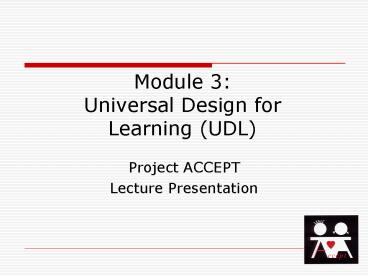Module 3: Universal Design for Learning (UDL) PowerPoint PPT Presentation
1 / 21
Title: Module 3: Universal Design for Learning (UDL)
1
Module 3 Universal Design for Learning (UDL)
- Project ACCEPT
- Lecture Presentation
2
What is Universal Design for Learning?
- One-size-fits-all
Acknowledging the need for alternatives to suit
many different peoples needs
3
Universal Design for Learning (UDL)
- Concept or philosophy for designing and
delivering products and services that are usable
by people with the widest possible range of
functional capabilities (Technology Act of 1998).
4
UDL Principles
- Multiple means of representation
- gives learners various ways of acquiring
information and knowledge - Multiple means of expression
- provides learners alternatives for demonstrating
what they know - Multiple means of engagement
- taps into learners interests, challenges them
appropriately, and motivates them to learn
(www.cast.org)
5
Birth of Universal Design
- Two factors contributed
- The need for accessibility into buildings for the
population as a whole - Problems caused by retrofitting buildings
- (Rose, 2003)
6
Emerged from Architectural Design
- Access to buildings was needed for various
persons, including individuals with disabilities - (e.g. Individuals using wheelchairs could not
enter) - Architects started creating structures that were
accessible to the widest spectrum of users at
little or no extra cost - Accommodations were subtle, integrated into the
environment/structure from the planning stages to
completion
7
Universal Design
- The design of products and environments to be
usable by all people, to the greatest extent
possible, without the need for adaptations
8
Universal Design and Education
- Educators have expanded the Universal Design
concept into education to limit barriers to
learning.
9
Barriers to Learning
- Students with disabilities have
- difficulty accessing sensory, physical, and
cognitive information without accommodations
specific to individual needs. - Difficulties include
- Accessing electronic media
- Receiving information in auditory format only
- Classroom arrangement not set up for students
with physical disabilities
10
Universal Design for Learning (UDL)
- UD curriculum includes
- Goals that provide an appropriate challenge for
all students - Materials in a flexible format and in multiple
representations of content to support all
students learning - Methods that are flexible and diverse to provide
learning and supports for all students - Assessments that are flexible and accurate
- to provide ongoing information for the
- teacher
11
UDL is not
- Lowering standards
- Dumbing down the curriculum
- Finding the least common denominator
12
UDL
- In a diverse, inclusive classroom, learners must
understand that fair does not mean that
everybody gets exactly the same thing, but rather
that everybody gets what they need (Voltz, 2005).
13
Four Fundamental Assumption of UDL
- UDL proposes that children with disabilities do
not constitute a separate category but instead
fall along a continuum of learner differences. - 2. UDL leads us to make adjustments for learner
differences for all students, not just those with
disabilities. - 3. UDL promotes the development and use of
curriculum materials that are varied and diverse,
including digital and online resources, rather
than centering on a single textbook. - 4. UDL transforms the old paradigm of fixing
students, so that they can manage a set
curriculum by making it flexible and adjustable
(http//www.cast.org).
14
UDL Improves Learning
- Meets individual learners needs
- Electronic learning materials provide
accessibility - Multiple pathways to learning provided
- Maximizes learning opportunities
- Fosters growth and independence
- Provides access within the regular education
environment
15
Tools for Designing UDL
- Planning Pyramid
- UDL Lesson Plan
- Considerations Matrix
16
(No Transcript)
17
Planning Pyramid Example for a science unit on
cells
- What some students will learn
- Speculation of cells in multi-celled organisms
- Function of cells in human tissue and organs
- Preparation of slides of cells
- Cell transport
- What most students will learn
- Similarities and differences of animal and plant
cells - Parts of cells as viewed with a microscope
- 3 main points of cell theory
- How diffusion works
- Mitosis
- What ALL students should learn
- Nine major parts of all cells
- Use of microscope to view cells at different
organisms - Photosynthesis
18
UD Lesson Plan
- Project ACCEPT lesson plans
- Blank Lesson Plan
- Primary Lesson Plan
- Secondary Lesson Plan
19
Considerations Designing Lessons Accessible to
ALL Learners
- Input How will the content be delivered
- Output What types of student responses will be
expected? - Characteristics What are the learners needs
(based on the IEP)?
20
What is an Infusion Matrix?
- A tool used to ensure that students goals are
being met within the context of inclusive
environments. - Delineates which of the students IEP goals and
other priorities can be addressed within relevant
classes, subjects, school activities, and
community experiences. - Provides a method for targeting student
participation within classes, subjects,
activities, and settings. - Assists in determining whether a student might
need educational experiences in environments
other than the typical classroom setting.
21
Resources
- Friend, M. Bursuck, W.D. (2006). Including
students with special needs A practical guide
for classroom teachers (4th ed.). Boston Allyn
Bacon. - www.cast.org
- Project ACCEPT

